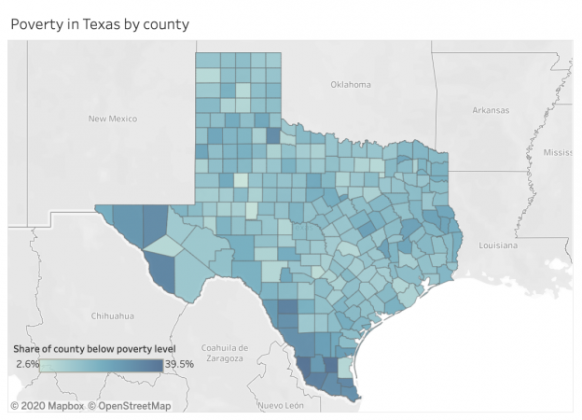Statistical data analysis shows income levels for Lone Star State
Contributed
The map shows the percentages of poverty level individuals in each county. The darker blue counties have a higher rate of poverty. Border counties trend more towards poverty than other Texas counties
Texas may rank 14th in overall state poverty rate, but Burnet and Llano counties fare better than average when it comes to income level, a new study of U.S. Census Bureau data shows.
Analysis by website Stacker of five-year population estimates contained in the 2014-18 American Community Survey shows Burnet County, which had a population of 47,542 in 2018, had 4,984 people living below the federal poverty level (FPL), or 11 percent, putting the county in 207th place overall out of 254 counties when it comes to percentage of residents living in poverty.
Meanwhile, Llano County, which had a population of 21,646 in 2018, had 2,376 people living below the federal poverty level (FPL), or 11.6 percent, putting the county in 201st place overall out of 254 counties when it comes to percentage of residents living in poverty.
The three counties with the highest percentage of residents living in poverty are Zapata County with 39.5 percent (5,609 people); Brooks County with 38.9 percent (2,573 people) and Starr County with 35.3 percent (22,336 people). Zapata and Starr are both border counties to Mexico, while Brooks County is just north of Starr County.
“Much of the poverty in Texas is located in communities, largely Hispanic, along the Mexican border,” according to the survey conducted by Stacker. “Rates of poverty in South Texas and in the Rio Grande Valley are twice as high as statewide rates. Poverty in McAllen and Brownsville, two cities in the Rio Grande Valley, affects about four in 10 children, and child poverty in Laredo, also on the border, is nearly as high.”
The three counties with the lowest percentage of residents living in poverty are Borden County with 2.6 percent (17 people); Sterling County with 3.5 percent (39 people) and Kendall County with 5.3 percent (2,178 people).
Overall, Texas has 4,213,938 people living below the poverty line or 15.5% of the state’s population—the #13 highest rate of poverty among all states. The child poverty rate for the state is even higher as 22 percent of all Texas children (1,589,798) live in households where familial income does not meet federal standards.
The FPL threshold for one person under the age of 65 is an annual income of $13,300; the FPL for a family of five with three kids is an annual income of $30,510.
The U.S. FPL is a metric first used in the 1960s that is based on the cost of a minimal food budget multiplied by three on the assumption that food comprises a third of a household’s expenses. The FPL is used as a threshold for determining an individual or families’ eligibility for assistance programs from SNAP benefits to Medicaid. Various social services have different caps for eligibility from 100 percent of the FPL or higher.
Statistics also show poverty disproportionally affects African-Americans and Hispanics when compared to their white counterparts. In Texas, 22.1 percent of all Hispanics — 2,365,585 people — live at or below the poverty level, while 20.3 percent of African-Amercians (654,449 people) do. Just 8.7 percent of all white Texans (1,000,468 people) live below the poverty line.
Just over one in 10 (10.5 percent) of all Asian-Americans in Texas (135,831 people) live at or below the poverty level, while 17.9 percent of Native Americans/Alaskans (23,587 people) do so.
“Poverty rates in America also reveal a disturbing racial gap, with black Americans 2.5 times more likely to be poor than white Americans, according to the Kaiser Family Foundation,” the survey by Stacker reported. “Research generally points to causes like poor education systems, workplace discrimination, and high incarceration rates.”
Stacker’s findings also looked at the correlation between poverty and coronavirus and determined that COVID-19 has especially hit low-income black communities “disproportionately hard.”
“Experts say there is more likelihood of underlying medical conditions that make black people vulnerable, such as diabetes and heart disease,” the survey reported. “Those communities tend to have less access to good health care and have higher populations of essential workers who cannot stay home and are forced to stay on the job and risk getting infected.”



